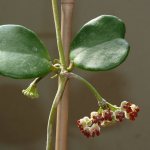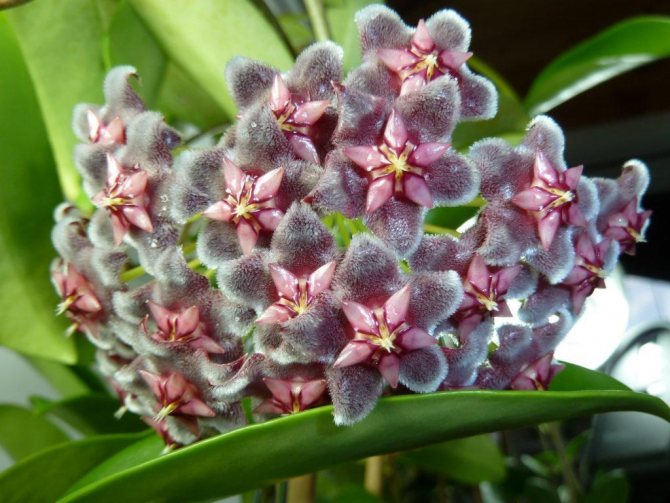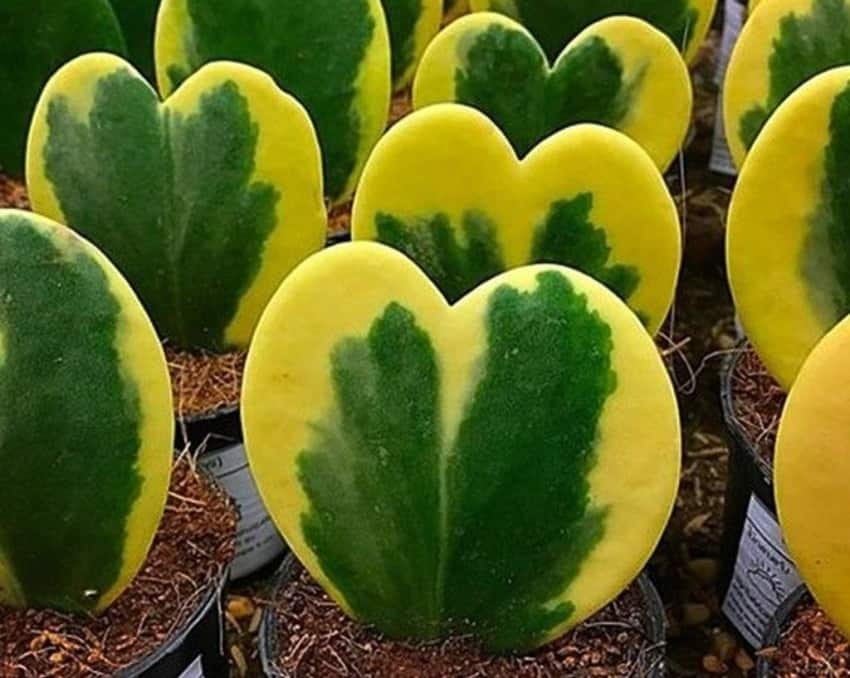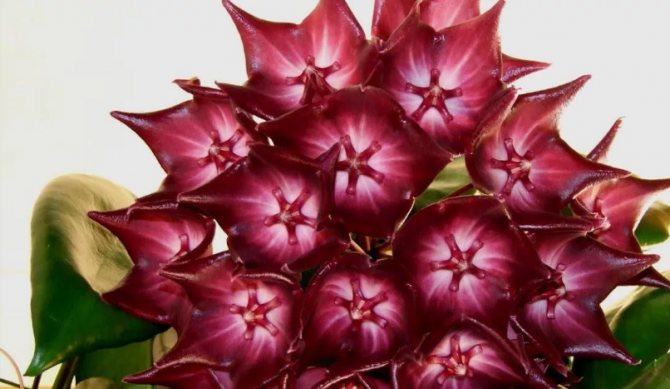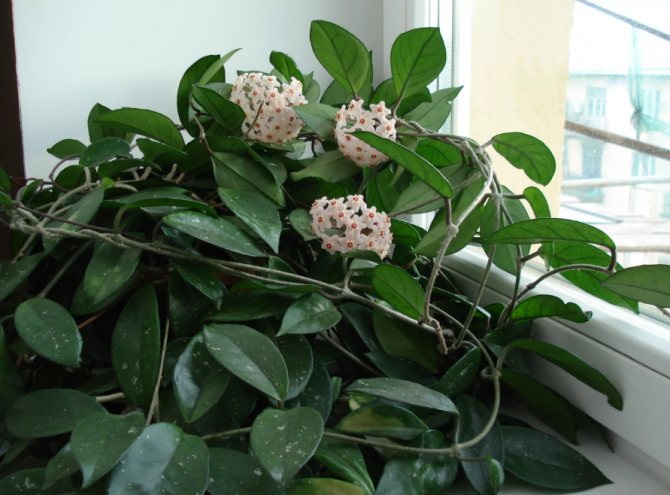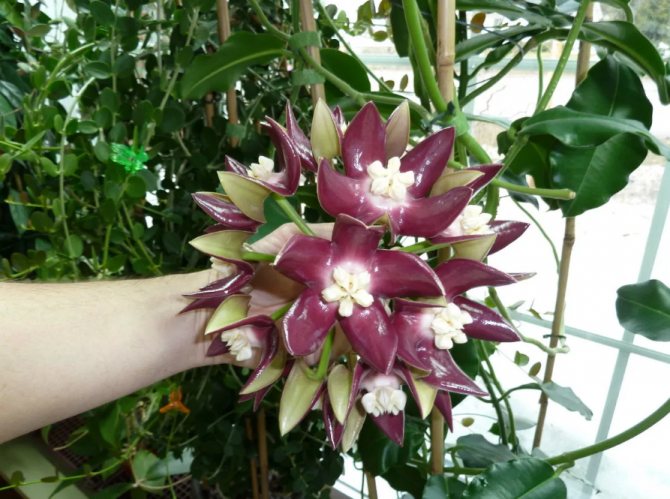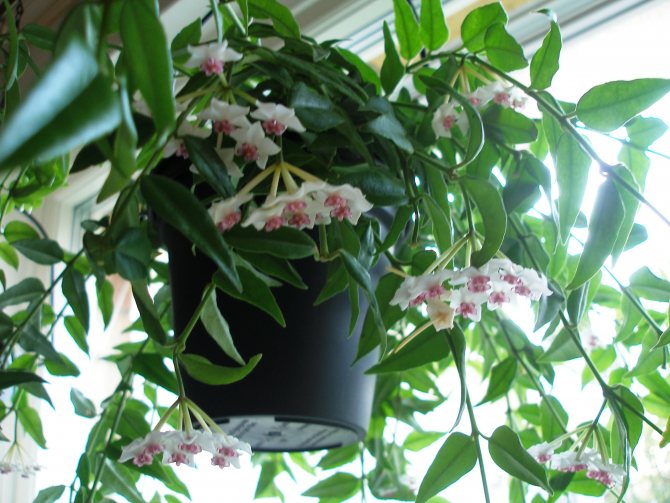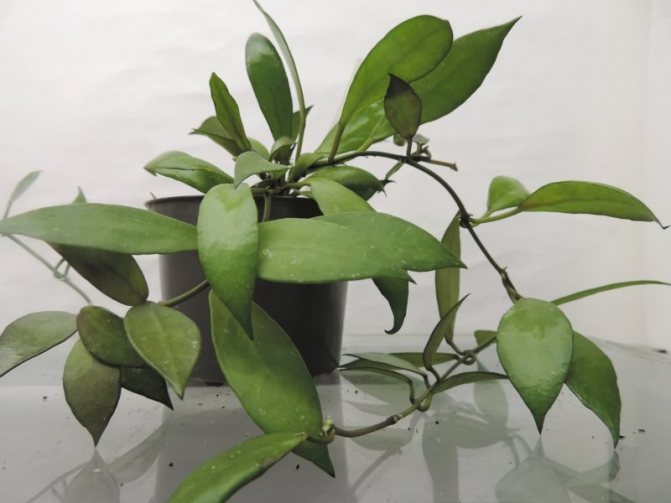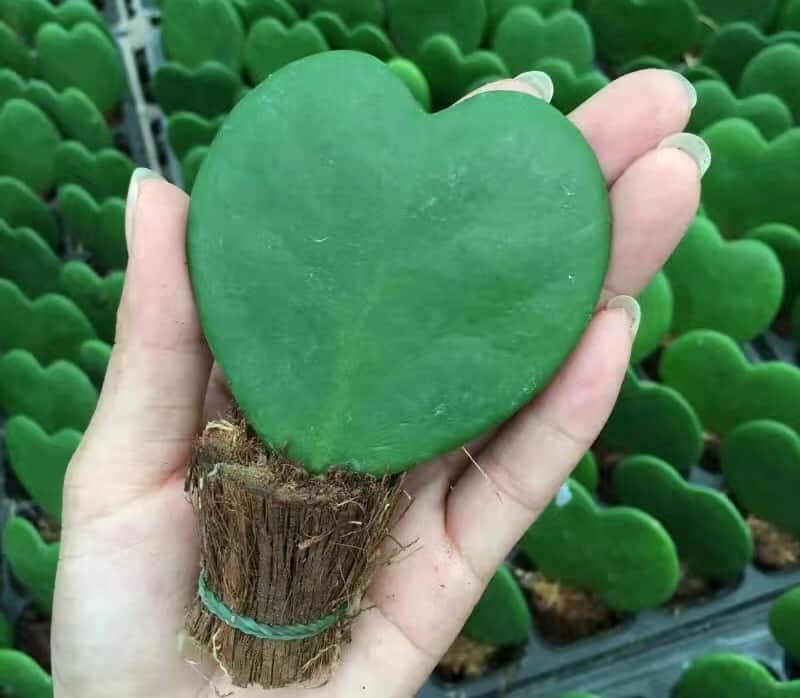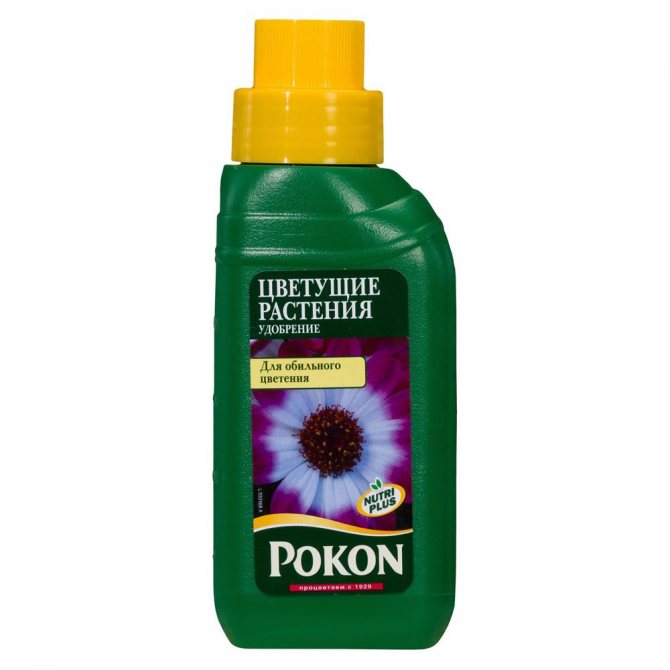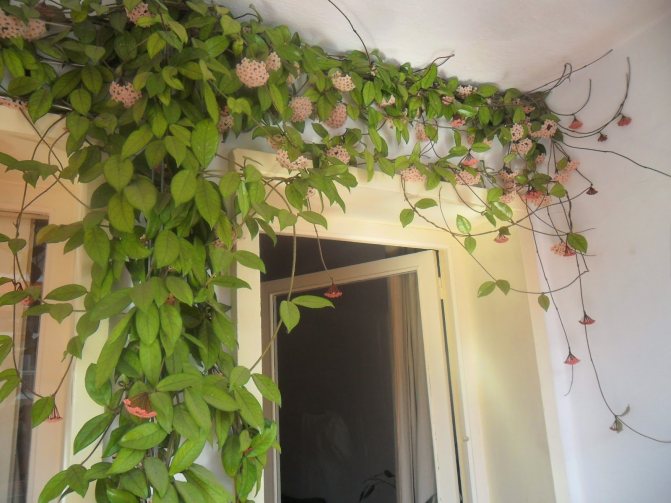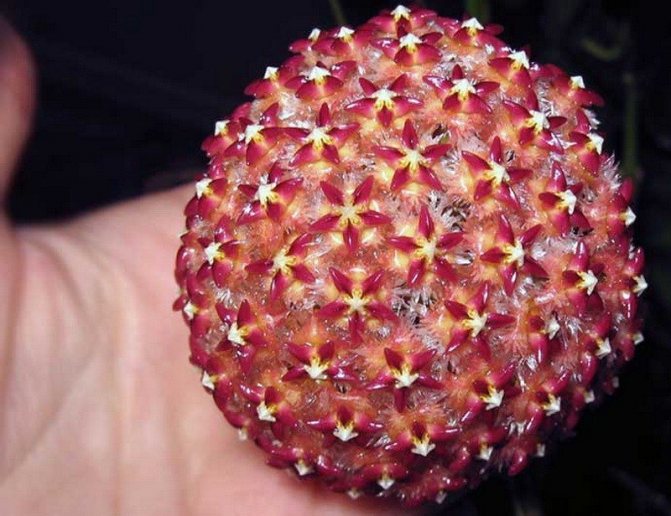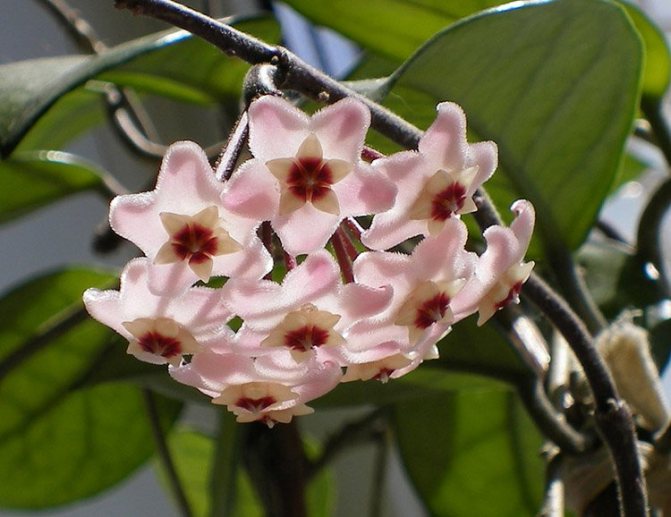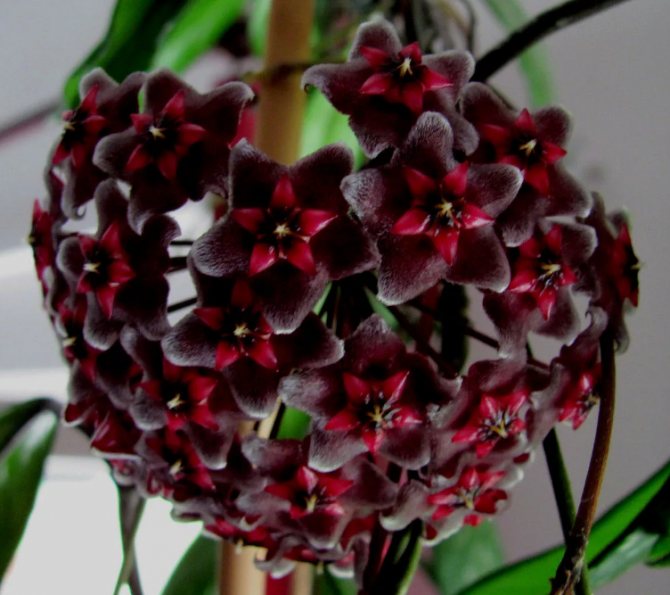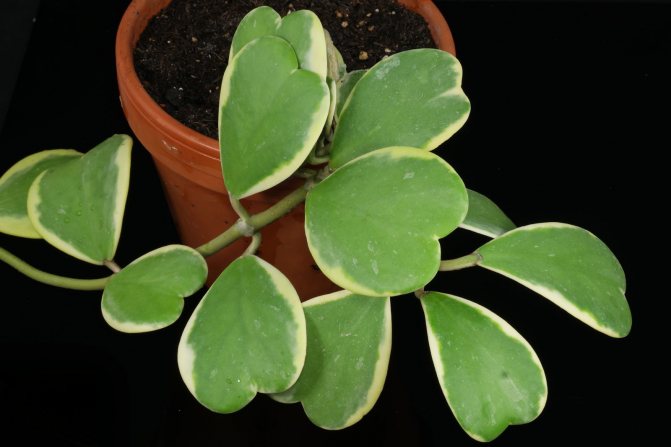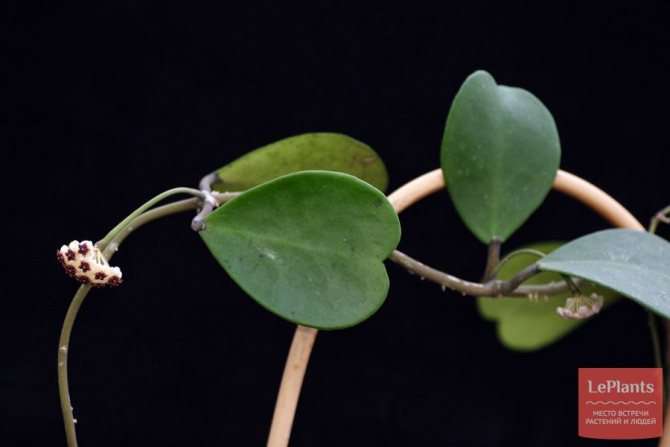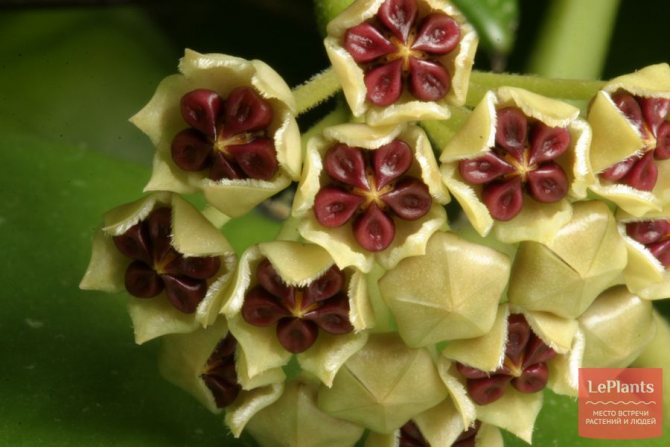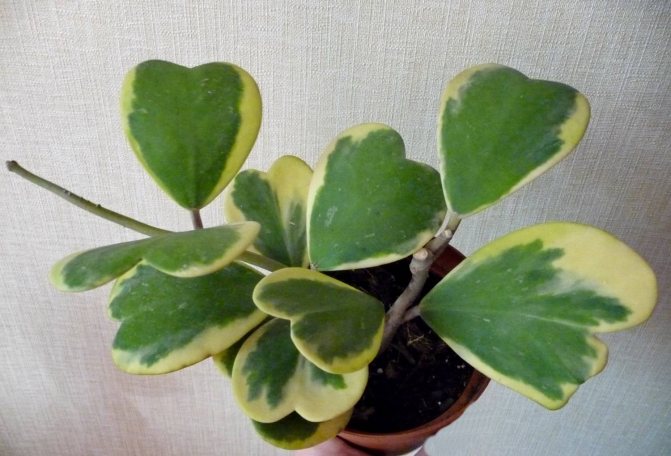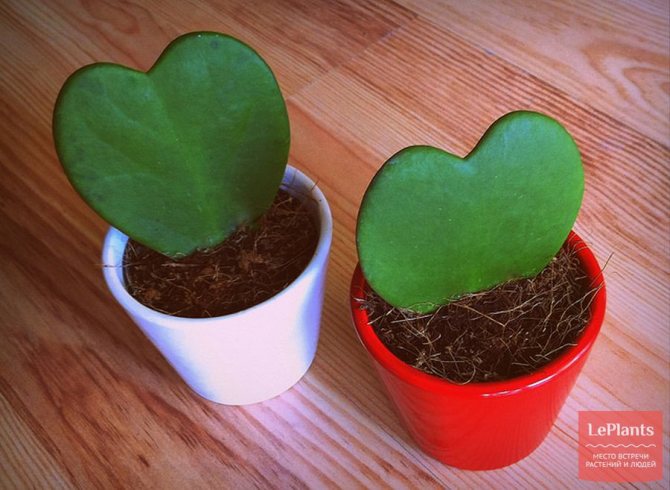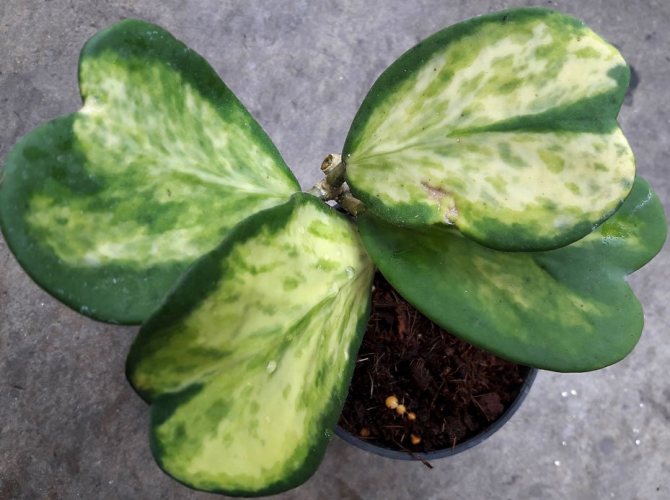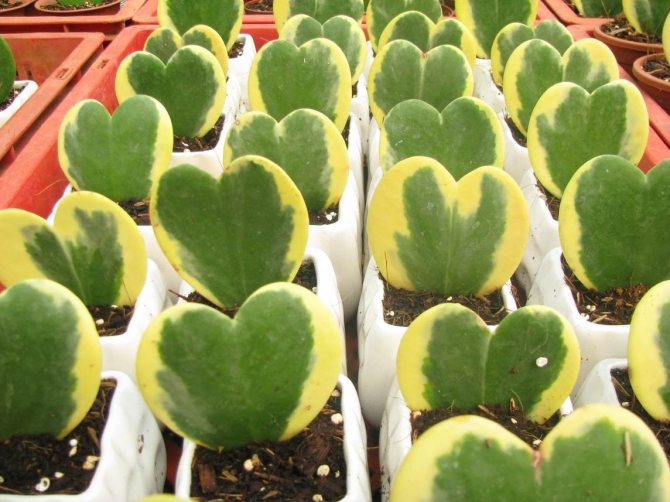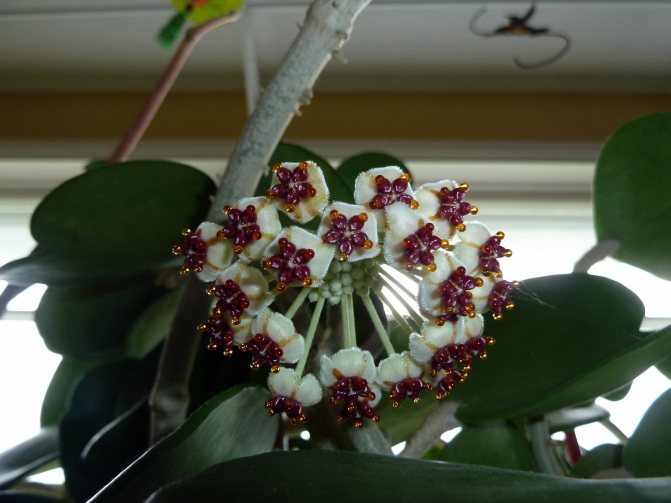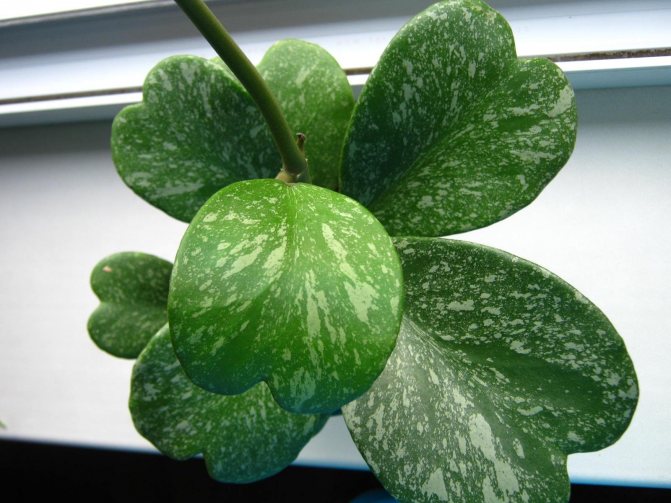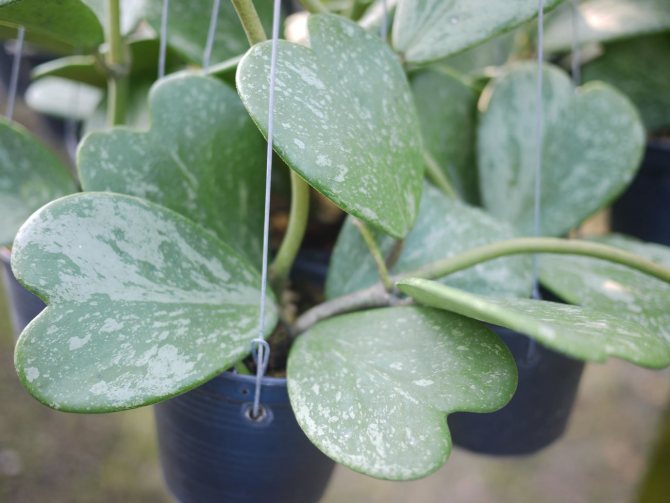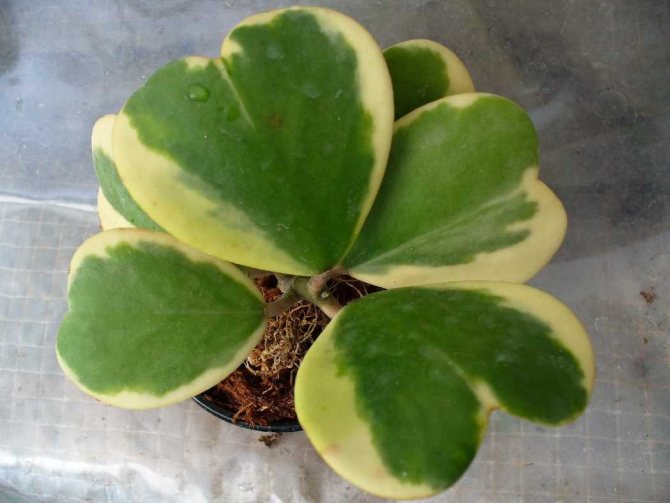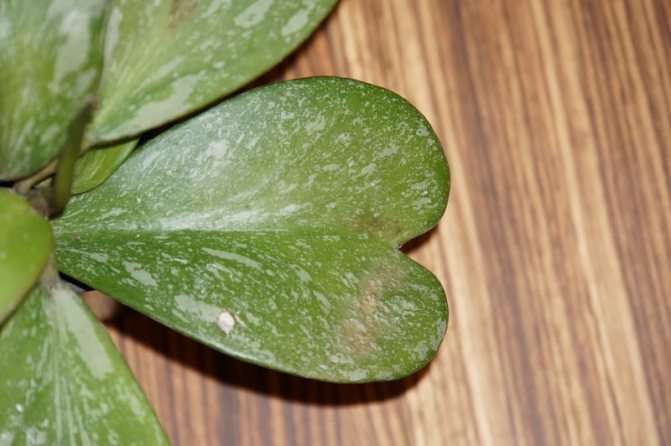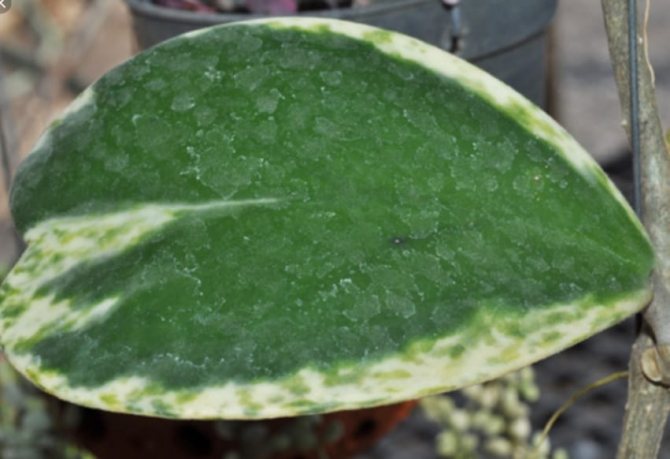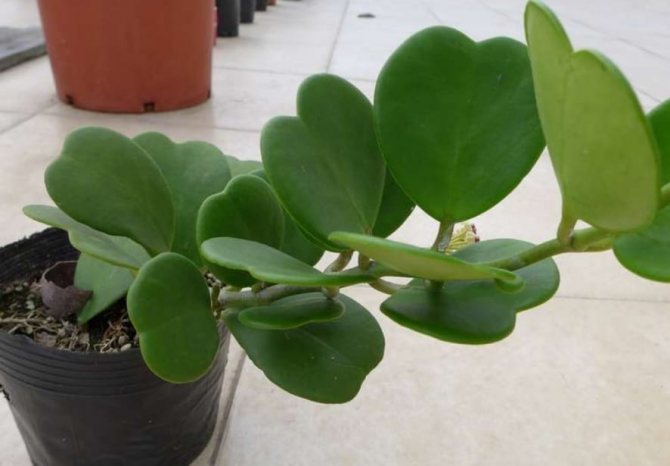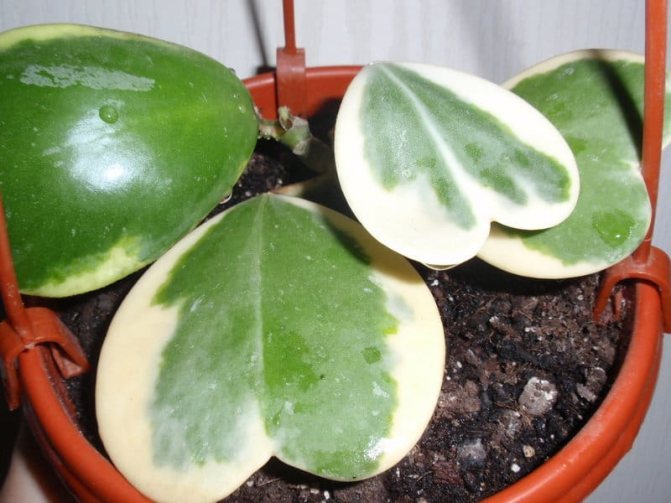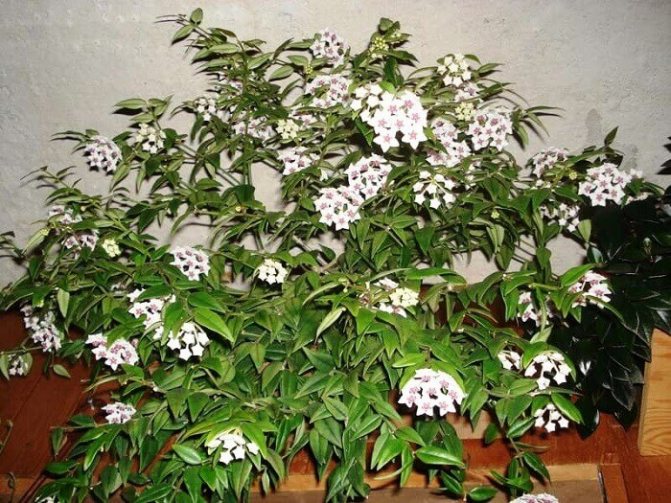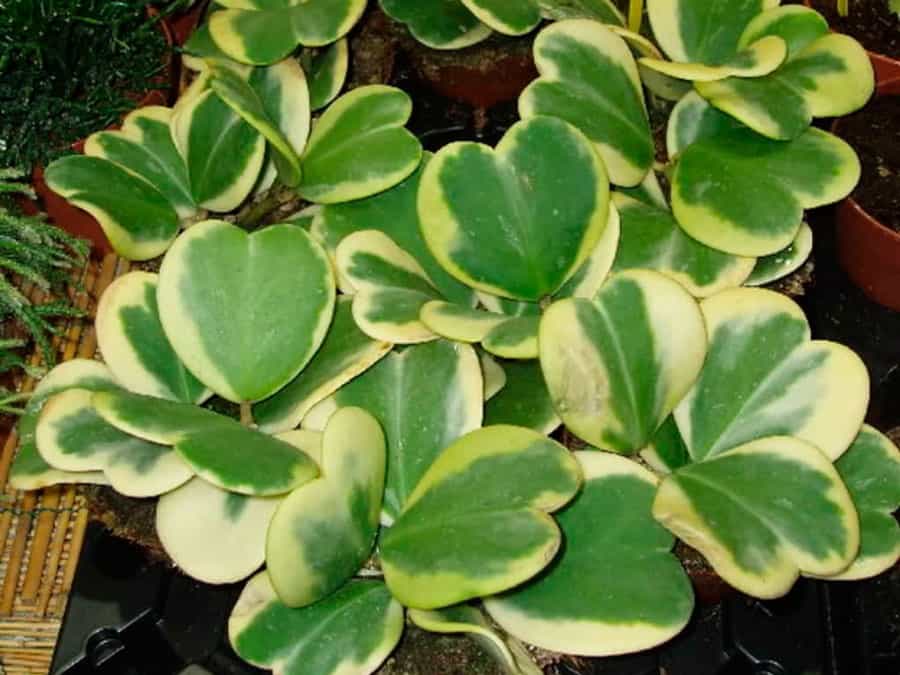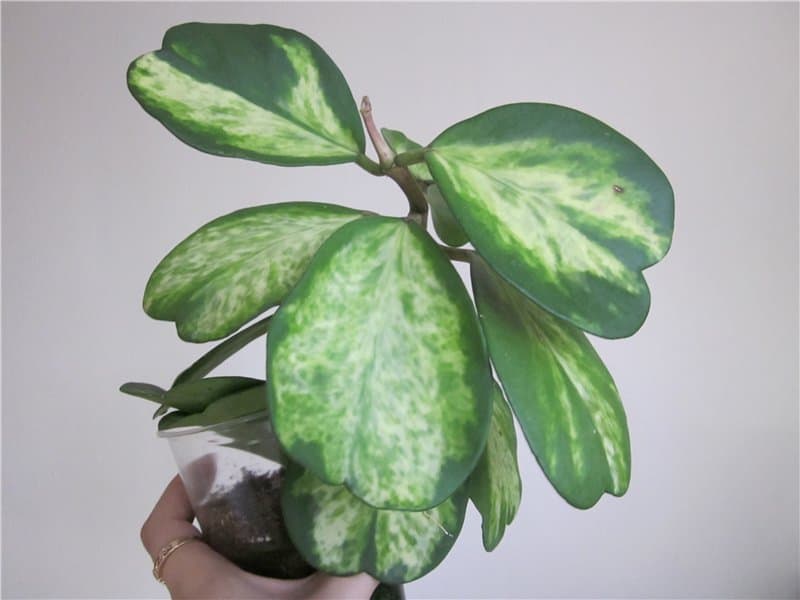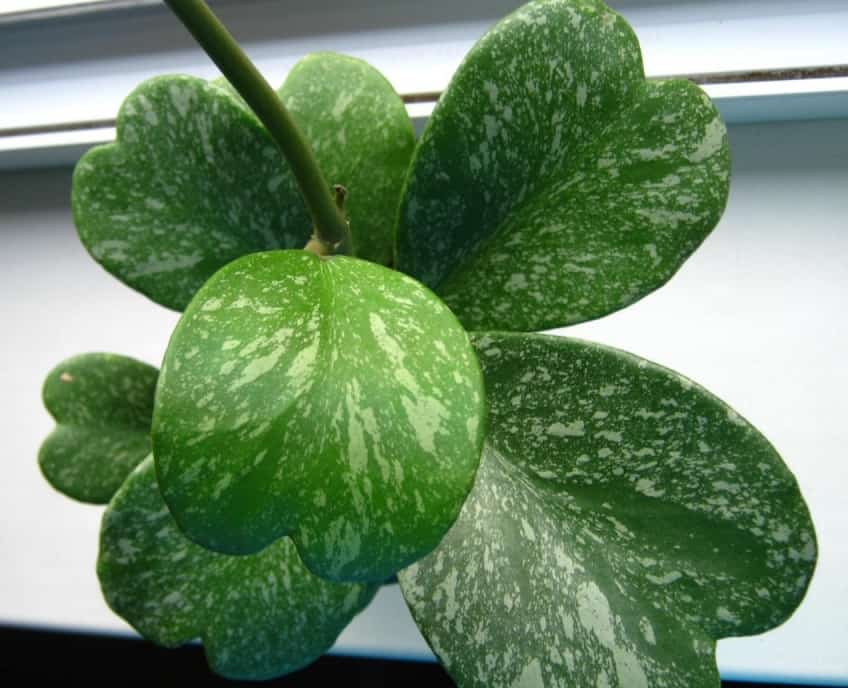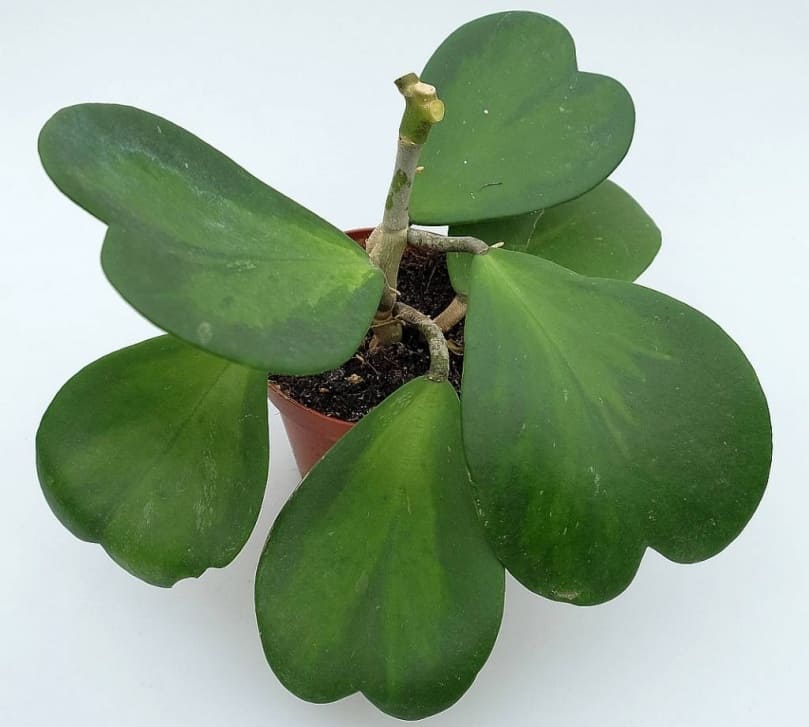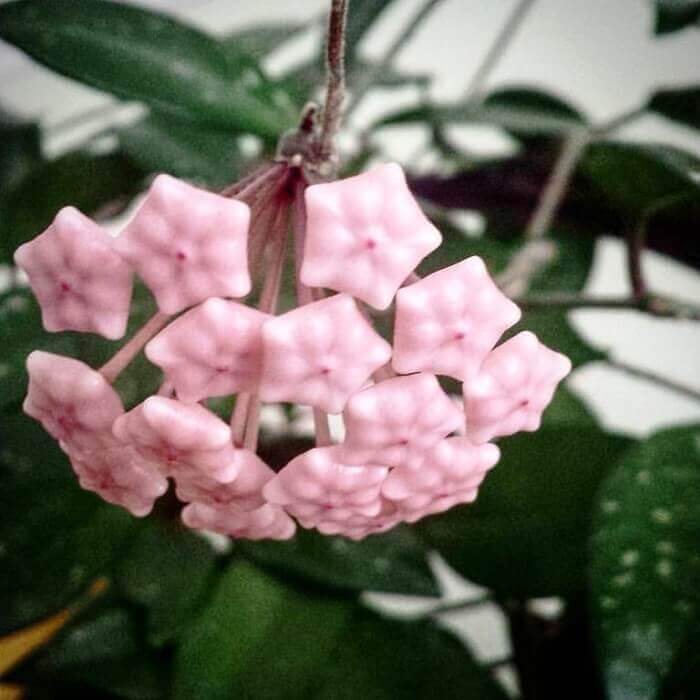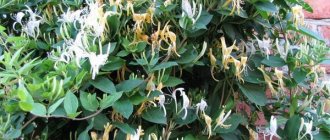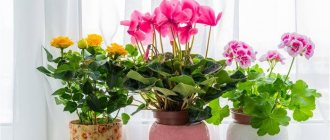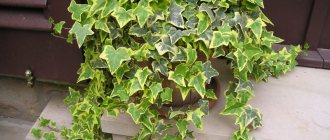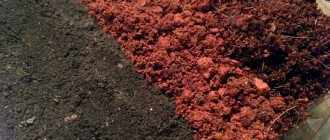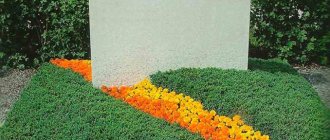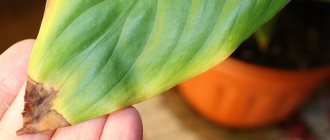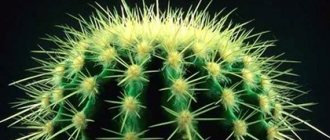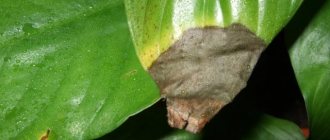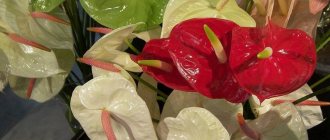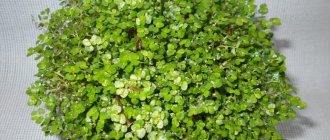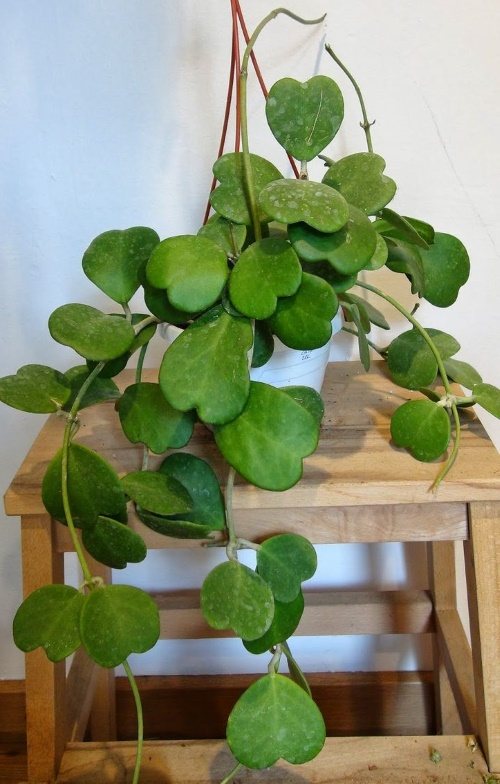
Many flower growers dream of getting themselves a hoya for the sake of its charming and long flowering. But hoya kerry will be able to fully satisfy all requests, because she has gorgeous not only flowers, but also leaves. For their original heart-shaped shape, the plant is called a symbol of love. The liana will also please with its varied color, because it has many variations of variegated varieties.
Is it possible to keep hoya wax ivy at home
This question cannot be answered unequivocally. Someone will say that it is possible, someone will say that it is impossible. There is a superstition among the people that ivy is unfortunately in the house. It is because of this that people do not want to decorate their home with hoya. In addition, some mythical properties are attributed to her:
- When the hoya blooms, it means a period of great problems for the owner.
- Ivy drives men away, destroys marriage and makes women unhappy.
- In a house where ivy grows, financial problems arise.
But wax ivy also has defenders who refute negative rumors and attribute positive properties to this plant.
For example, the hoya's ability to pacify enemies, envious people and gossips.
So can hoya (wax ivy) be kept at home? Everyone decides for himself, but it should be remembered: indoor plants create comfort and neutralize harmful substances in the air.
How to propagate at home
There are three methods of plant propagation, but only two of them are usually used in practice. Let's see why below.
Layers
To get layering, you need to make an incision on the side stem and wrap it with a film, under which you put a layer of wet moss. For a more reliable fixation, the film is tied with a string. After a while, roots will appear from the cut.
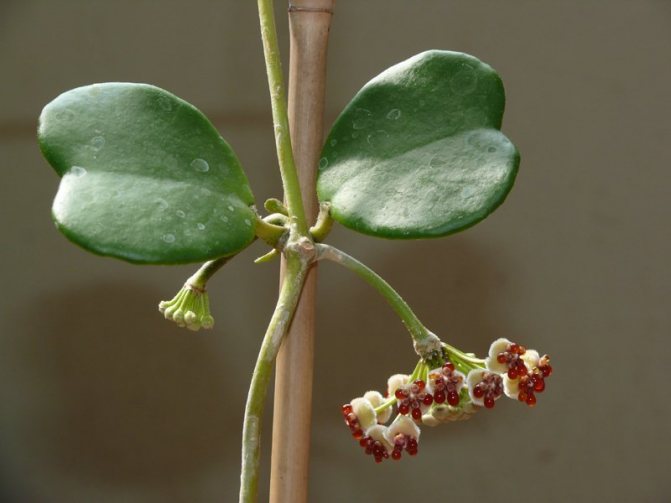

The side shoot must be cut so that the roots are at the very bottom and planted in a pot. When 3-4 leaves appear, follow the pinching procedure to make the vine more branched.
This method is usually used by those who want their tropical flower to bloom as quickly as possible. The hoya grown from the cut will delight you with the first buds in a year.
Where to put ivy hoya in feng shui
Hoya has a very soft energy that has a positive effect on the atmosphere in the house. Wax ivy can destroy negative energy and bad emotions. According to feng shui, hoya helps to stabilize energy in the house, helps households to forget about problems and gives peace of mind.
In addition, hoya is able to help build relationships between colleagues and even helps to advance the career ladder.
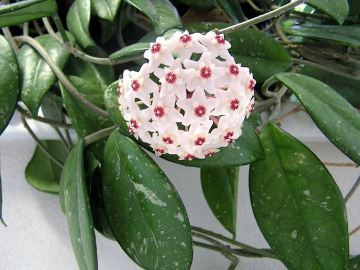

Hoya is called the flower of family happiness, because it helps to improve relations between spouses, rekindles former passion, and returns the acuteness of feelings. To improve family life, it is recommended to put a wax ivy pot in the bedroom. This will help harmonize relationships and improve family life.
Hoya can be placed in the children's room, then it will help the child become more independent, make the necessary decisions quickly, and become more self-confident.
If you put the hoya in the living room, then its action will be aimed at making the household relax faster after a hard day and calm down faster.
It is important to remember: if you are prone to laziness, then hoya will not suit you, as it will only aggravate the situation.But for pessimistic people, wax ivy will come in handy - it will help to tune in a positive mood.
Hoya is exactly the plant that will bring comfort and tranquility to the house.
Plant propagation
At home, hoyu is theoretically propagated in three main ways.: seeds, cuttings and layering.
- Seed method in practice, they are not used at home. Due to its inefficiency, not productivity. It is quite rare for a plant to set seeds, and buying them is a problem. Even if the seed has been purchased, it is worth the great effort to grow a young flower.
- Cuttings considered the most common effective breeding method. The created conditions do not always allow the process to take root, this can be expected for more than one month. And flowering will come after 4 years. On the other hand, the grafting method is simple to execute and even beginner growers can do. It is possible to get a new copy similar to the parent one. No investment required.
- Reproduction by layering... On the stalks of succulents, air roots can be discerned, which easily branch and take root. The advantage of this method is the rapid flowering of the sprout, for which it takes less than a year.
Hoya kerry, like other exotic plants, loves warmth. Therefore, it is important that the flower is not exposed to hypothermia. She also needs patient and caring owners, because one should not expect rapid growth. You need to remember the main thing: do not disturb during rest and maintain humidity in the room. Then, after 3 years, the plant will endow others with its flowering.
If you find an error, please select a piece of text and press Ctrl + Enter.
Hoya wax ivy bring misfortune?
Many people are opposed to this plant in the home, as there are many negative superstitions associated with it. One of them says that the hoya drives men out of the house and brings loneliness to women. It is believed that the husband, as well as the sons, will "run away" from home when such a plant appears in him.
This can be avoided only by throwing it away (and with it all the misfortunes). But all these superstitions have nothing to do with wax ivy, since they relate exclusively to ordinary ivy. Hoya can only drive out enemies and liars from life.
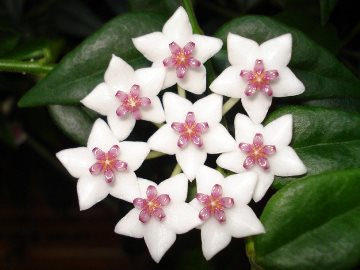

In addition, wax ivy is quite good coexisting with other plants. Unlike ordinary ivy, hoya does not draw vitality from them.
Wax ivy blooms unusually beautifully. Depending on the type of plant, the flowers are different and smell very nice. And because of the aroma, another superstition is imposed on the hoya - the hoya can poison a person with its smell. But this is not true either. The plant does not contain toxins and harmful substances, but it can cause allergies during active flowering.
Description and popular varieties
Hoya Kerry belongs to the genus of tropical lianas. Its homeland is considered to be Polynesia, the southern regions of Asia, Australia. The main distinguishing feature of this plant is a heart-shaped leaf. Stem shoots grow to a considerable length, therefore they require support and support. In their natural habitat, vines lead an epiphytic lifestyle; trees and large shrubs are used as props.
This variety, in turn, has a number of subspecies that differ in the color and shape of the foliage, variegated plants have leaves with variegated spots:
- Hoya kerrii is a common green foliage.
- Hoya kerrii Spotted Leaves - speckled leaves.
- Hoya kerrii Variegata - yellow variegation is observed in the center of the leaf plate.
- Hoya kerrii Albomarginata - a light border is visible along the edge of the leaf.
- Hoya kerrii Spot center - an elongated leaf shape with a variegated color in the center.
- Hoya kerrii Spot margin - leaves with a white edge and a green center.
For reference! Mostly all subspecies are characterized by fleshy, dense leaves, veins on them are practically invisible.The length and width of the heart varies from 5 to 15 cm.
The flowers, in turn, are yellow, pink, white, red. The brightness of a color can be affected by the intensity of the light. In adults, more nectar is released, which leads to darkening of the shades. Flowers are collected in umbellate inflorescences. Their size is 1-2 cm in length. During flowering, kerry needles give off a pleasant, persistent aroma.
The harm and benefits of a flower for humans
Studies have shown that hoya is a beautiful, harmless decorative flower that is perfect for decorating residential and non-residential premises. But even the most beautiful flower has positive and negative properties.
Harmful properties:
- Aroma. A strong odor can cause allergies, especially if the flower is in a small room. Therefore, you should not place hoya in homes where there are allergy sufferers or children with diseases of the lungs or respiratory system.
- The juice. The sap of the plant can irritate the skin, so you need to take all precautions when working with the flower.
Beneficial features:
- Hoya purifies the air, produces the necessary oxygen.
- The foliage of the plant is used in the treatment of furunculosis and carbunculosis.
- Improves well-being, provides a surge of vitality, helps to unleash creativity.
- Perfectly decorates the interior.
What diseases does Hoya kerrii suffer from?
Hoya has good immunity, so it is practically not susceptible to diseases. Only in advanced cases, it is possible to be affected by fungal infections. With improper watering - rotting of the root system. Then part of the damaged roots should be amputated, sprinkled with an antiseptic and treated with a systemic fungicide.
In a dry and warm room, harmful insects spread quickly without natural air circulation... Among them:
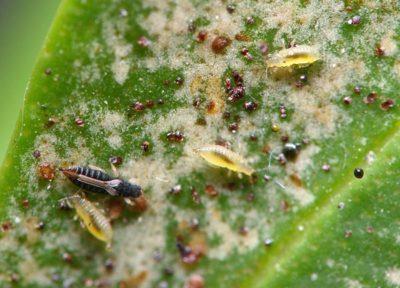

mealybug;- whitefly;
- shield;
- spider mite;
- aphid;
- thrips.
Pests feed on the sap of the plant, as a result of which the flower is depleted, withers, dries up, which is a signal that the exotic is not feeling well. If such neighbors are found, the hoya should be carefully treated with an insecticide solution. For the purpose of prevention and gentle treatment, folk remedies are used.
- Garlic infusion.
- Pour 15 g of finely chopped garlic cloves with 1 liter of warm water.
- Let stand for a couple of hours, then strain.
- Wash the leaves with this mixture or spray the flower.
- To improve the therapeutic effect, you can put a plastic bag on the plant and leave it for a day.
- Soap solution. Dissolve 15 g of laundry soap in a liter of warm water. Each leaf is wiped by hand with this mixture.
Signs and superstitions about wax ivy
Hoya is simply shrouded in negative beliefs. The plant is credited with attracting negative energy, as well as driving away men. In addition, the hoya is called an energy vampire. But there are also good superstitions, although there are very few of them.
People do not want to keep a climbing flower in the house, because it is able to draw out the energy of living beings. It is because of this that previously climbing plants were planted near the entrance - they took away the negative energy of guests entering the house. But hoya does not draw out vitality, this is evidenced by the fact that other plants get along well next to it.
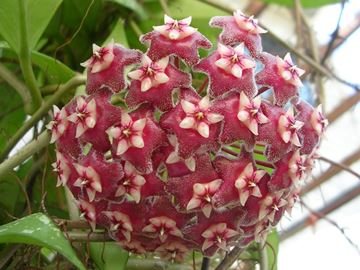

Hoya wax ivy is also believed to bring misfortune. Many people argue that with the advent of wax ivy in the house, its inhabitants began to have problems in almost all areas of life. And after getting rid of him, everything immediately returned to normal. But the plant should not be blamed for this, first you need to pay attention to yourself and your behavior.
Hoya is not recommended for unmarried girls, as it is believed that the plant will scare away grooms from them. In an apartment where there is a hoya there will be no men - this is what some superstitious people think.But this is a fundamentally wrong statement - family relationships are the work of the people themselves, and flowers have nothing to do with it. On the contrary, wax ivy will help strengthen the marriage union.
Why are there such contradictory signs about this plant? Because hoya grows in many people, and some people have good relationships, while others do not. And it is very easy to blame the unfortunate plant for all the troubles.
What conditions need to be created
The tropical symbol of lovers loves warmth, light, moisture and nutritious soil: there is nothing difficult in fulfilling these requirements at home.
Seat selection
The growth and appearance of the flower depend on the correct choice of place. He loves light, but diffused, since direct sunlight can scorch his foliage. Based on this, the western or eastern windows will be the ideal location for the flower.
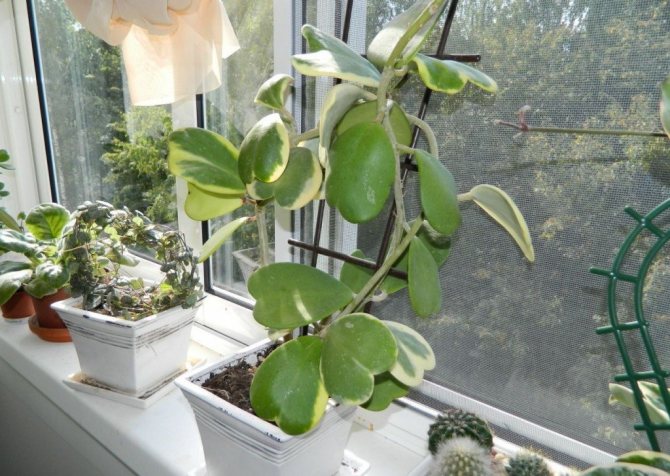

If possible, then it is advisable to install hoya on them in the second row, behind other colors, so that it is slightly shaded. This combination of light and shade will ensure that flowers appear annually in all internodes.
Important! When placing the plant, remember that during flowering sweet and sticky nectar appears, which can get on the windowsill, so the space around the pot
is worthcover with something.
Temperature
In spring and summer, it is necessary to maintain a room temperature - + 17 ... + 22 ° С. If the column of the thermometer rises a little higher, then it's okay, the main thing is that there is abundant watering and suitable air humidity. In the autumn-winter period, you need to lower the temperature a little, to + 16 ... + 18 ° С.
It is imperative to regularly ventilate the room all year round so that the humid air does not stagnate.
Air humidity
To maintain the humidity at the proper level, it is not necessary to place containers with water near the hoya. It will be enough to spray with warm water and arrange a warm shower weekly.
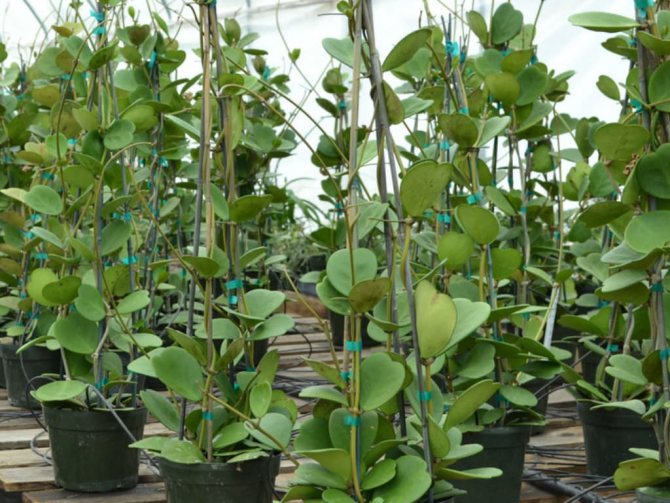

During flowering, it is necessary to ensure that moisture does not get on the flowers during these procedures. If this happens, then you need to immediately blot the drops. The remaining water can provoke the appearance of dark spots, which means that the decorative effect of the plant will be lost.
Signs on the state of the flower
Hoya is an unpretentious plant that is credited with a wide variety of properties. Depending on what is happening to him, you need to prepare for different life situations. There are a number of signs that indoor ivy can be kept at home.
If the hoya bloomed at the wrong time, then this portends misfortune in the family, which can lead to the death of a person.
If wax ivy has begun to dry, then you should pay attention to your surroundings, perhaps an enemy has appeared among loved ones. The flower absorbed its negative energy, thereby protecting the inhabitants of the house.
If the leaves began to turn yellow, then you should pay attention to the health of the household. Yellowing leaves indicate that the energy in the house is unhealthy, and appropriate measures should be taken to improve it.
Photo
A photo of a flower will help to appreciate the beauty of this type of vines.
If you decide to purchase a plant called Hoya, then first of all you should decide on the variety of this flower. We will tell you about the following types of Hoya: Lobby, Multiflora, Crimson Queen, Retusa, Compact, Gracilis, Matilda, Lacunosa and Cumingiana.
Hoya content beliefs
Most of the accents about hoya appeared due to incorrect identification of the plant. All the negative properties of ordinary ivy were transferred to wax (which, strictly speaking, does not belong to the ivy genus at all), so many people still treat it with caution.
Parasites and vampires
In the wild, ordinary ivy does not just grow next to trees and twine around their trunks - it literally grows into the root system and drinks the juices of the "owners", gradually oppressing the trees. Hoya, on the other hand, has its own root system and does not in any way affect other plants that grow beautifully next to it.
The belief that wax ivy is a parasite and an energy vampire is unfounded.
The plant that exorcises men
There is a sign: hoya in a dwelling - to the absence of men in it. Allegedly, if you bring a pot of ivy into the apartment, the flower will begin to "push" all males out of the house: sons will leave it long before they grow up, husbands will abandon their wives, older men will also leave their homes for various reasons ( up to premature death). If a young girl brings the hoya into the house, then she will never marry, but will live alone.
These signs are not based on anything. On the contrary, many of those who keep wax ivy are convinced that hoya strengthens the family. A plant can "drive" a man out of the house only if he is a liar and a true enemy of a woman, since the unique energy of the hoya is able to pacify enemies, gossips, liars and simply does not allow them to live in the same room with them.
Flower of family happiness
When difficulties arise between spouses, a certain category of people goes to psychics for help. However, many magical rituals aimed at returning harmony to the family have negative side effects.
If the psychic is really a competent specialist who wants to help clients, then often he simply advises them to have a hoya in the house. This plant is better than any magical rituals and, without side effects, can restore mutual understanding and strengthen marriage to spouses.
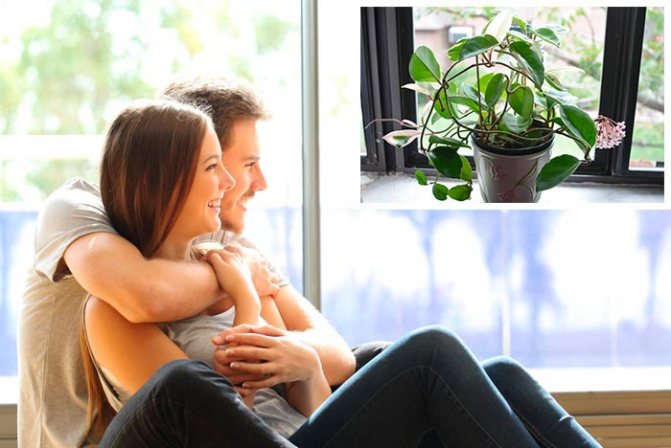

Is it worth taking into account beliefs?
Here, everyone decides for himself whether to start a hoya in the room or not. If you do not attach importance to them, you will take care of the flower, the plant will delight you with beautiful foliage and abundant color. But everyone who believes in omens should not "tempt" fate once again.
The plant itself, according to many, fits perfectly into the interior of any room, and its unpretentious care makes it a universal green favorite for everyone who does not have time to deal with flowers. Having this plant in the room, you can refute, or confirm, this or that superstition from personal experience and example.
SECRETS OF GROWING HOYA
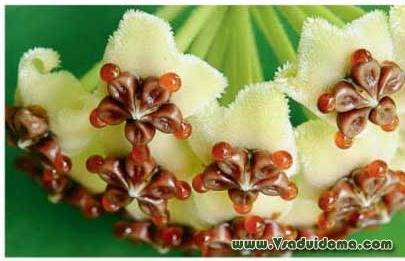

Hoya kerry belongs to slow-growing plants, but for normal development it needs proper care, and especially its location. The need for certain lighting is dictated by the biological characteristics of this flower - since it is a resident of the tropics, it needs abundant sunlight, but at the same time, it is an inhabitant of the forest canopy, which naturally develops under the crown of trees, therefore it is sensitive to too bright light. Based on such preferences of this hoya, it will feel best on the east or west windows, the southern window sills are also suitable for keeping it, but here it is better to shade the hoya pots, placing them behind more heliophytic plants.
In summer, the optimum temperature for keeping hoya kerry is 24-25 ° C, and the azimuth is about 15 ° C. Drafts are also dangerous and highly undesirable for this plant, therefore if your pet is in a cold and windy place, try to find more favorable conditions for it as soon as possible. But it should be remembered that the hoya is very sensitive to changes in lighting, therefore, having found a suitable place for her, it is no longer worth moving the pot.
It is also necessary to follow the rules of watering - like a succulent, this hoya does not need frequent and abundant watering, therefore, in order to avoid its decay, it is best to spray the plant once a week, and moisten the soil only after it dries.
If any of the care points are violated, then your plant will react by changing the color of the leaves or wilting their edges.
Types of homemade hoya with photos and names
The varieties of tropical hoya are numerous.Below are descriptions of the most prominent representatives of indoor plants of the genus Noua.
Hoya fleshy, or wax ivy
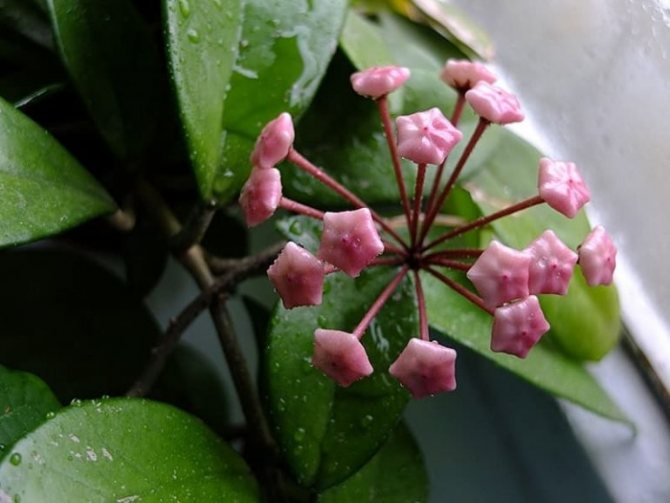

Hoya carnosa is a liana, the length of woody stems can reach 6 meters. Leaves are dark green in color with a cream or yellow rim, oval, fleshy, waxy. Star-shaped flowers (20-30 pcs.) Are collected in umbellate inflorescences of dark pink color. Long flowering (summer-autumn).
Hoya is beautiful
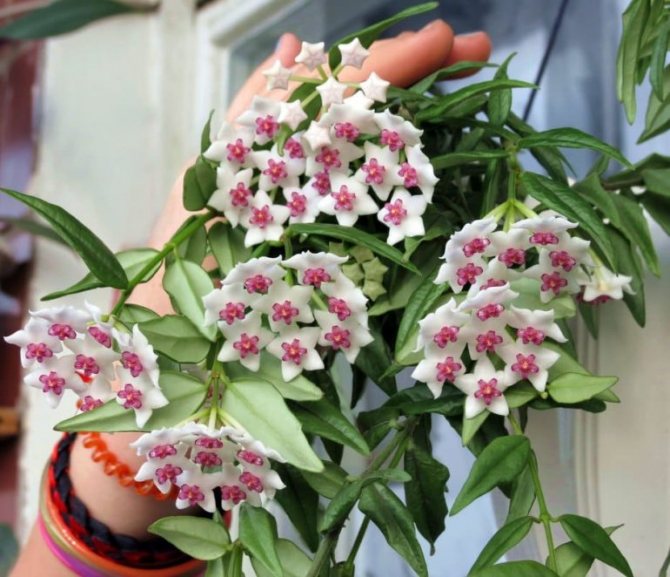

Hoya bella is a small epiphytic shrub with curly flowing thin stems. It has small oblong green leaves (3 cm), white inflorescences with a purple crown (7-9 pcs.), Collected in an umbrella-shaped bud. The flowering is stable, it falls in the summer.
Hoya lace
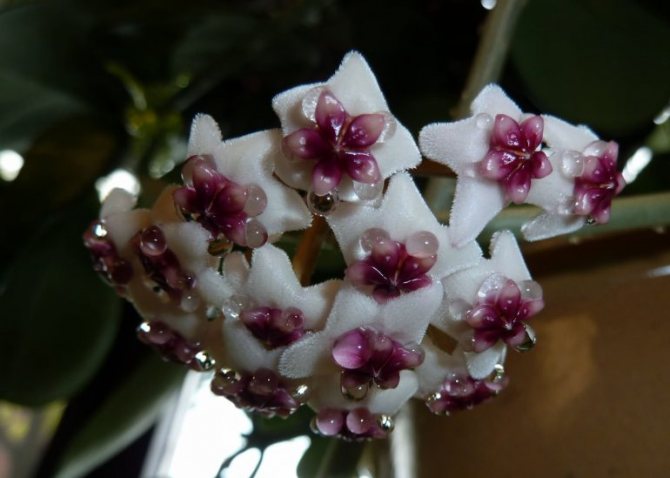

Hoya lacunosa - epiphyte. It has a dark green diamond-shaped foliage, reaching a length of 6 cm. Flowers in white inflorescences (15-20 pcs.) And a yellow crown in the center are covered with pile, collected from umbellate buds. The scourge of the plant is dense, does not curl on its own. Flowering is typical from late spring to mid-autumn.
Hoya multiflorous
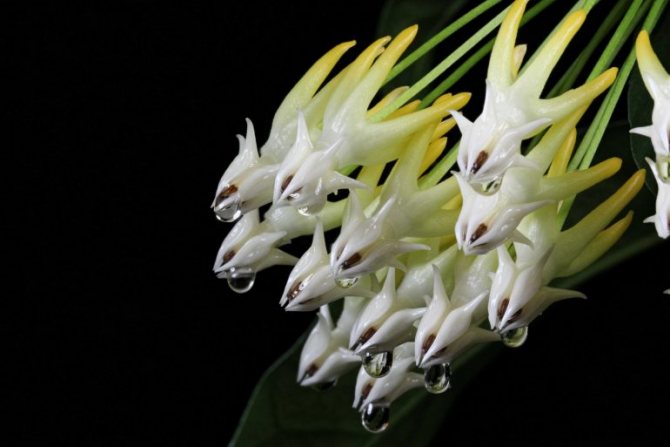

Hoya multiflora is a bushy plant with wavy waxy leaves of a dark green color, reaching a length of 10-12 cm. Thin woody stems do not curl - they are erect. It is grown as an ampelous plant, reaches a height of 60 -70 cm. Inflorescences are yellow-white (up to 40 pcs.), The lower part of the flowers is curved, the resulting buds have an umbrella-shaped shape. It has a pleasant lemon scent during flowering. The formation of buds falls at the beginning of summer and mid-autumn.
Hoya Kerra
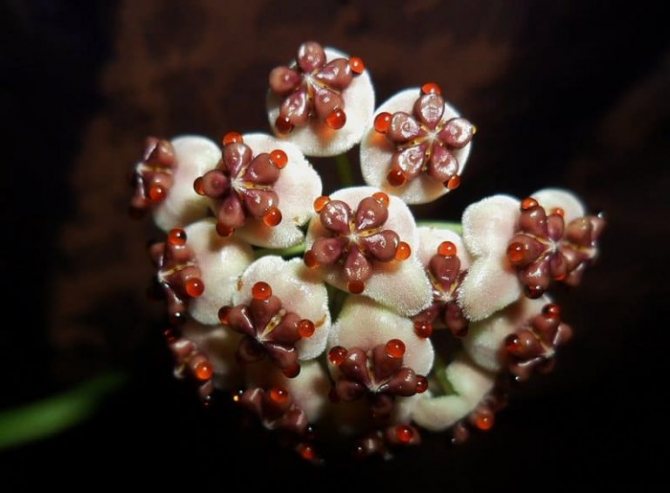

Hoya Kerrii is a large liana, with stems reaching a length of 2 m. It has large, light green, heart-shaped leaves (12 cm long, 9 cm wide) and thin stems with many aerial roots. The inflorescences are small, resemble flat stars, the middle is dark, the lower petals are pubescent, there are 25 flowers in the bud. During flowering, it emits a chlorine aroma. Abundant flowering is observed in summer.
Hoya majestic
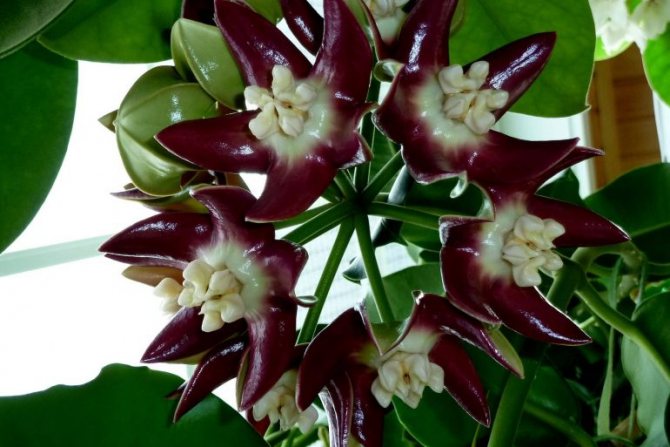

Hoya imperialis is a liana with curly thin stems reaching a length of 8 m. The foliage is large (20 cm long), oblong, dark green in color, glossy. Umbrella inflorescences consist of ten large purple flowers, the core is white. During flowering, they emit a fruity aroma. The buds form in spring and summer.
Hoya Australian or South


Hoya australis is a 10 m long liana with large dense waxy oblong leaves 15 cm long. The color of the foliage can be light or dark green. In one umbrella bud, there are up to ten flowers of white-pink or cream shade, emit a spicy aroma. Blooms mainly from late summer to November.
Pests and diseases
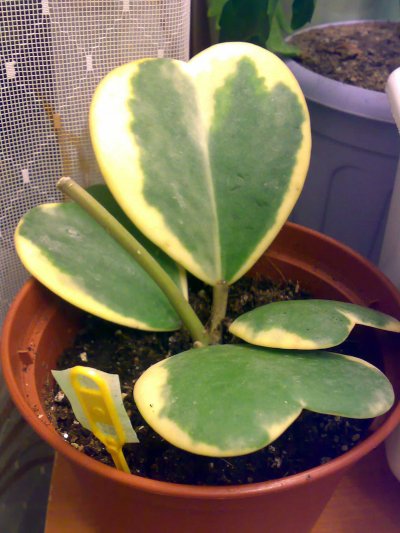

Spider mites and thrips
The main condition for the appearance of a spider mite is excessively low air humidity, so the plant needs to be sprayed regularly.
The appearance of the parasite can be determined by the appearance of yellow spots on the leaves and cobwebs. If the tick has managed to spread strongly, it should be treated with phytoverm.
Thrips also love dry air, spraying is used to prevent their appearance. To fight, you can use chemicals or use a folk remedy.
To prepare it, 15 g of crushed garlic or onions need to be poured into 1 liter of water, mixed and filtered. You need to rinse the plant with infusion, and to increase the effect, you can put on a plastic bag on it. Remove in a day.
Shield
Uit is parasitic on the whole plant and feeds on its juice. Their destruction begins with manual collection, then the plant is washed with concentrated soapy water. Per liter of water - 20 g of laundry soap. Next, the same garlic or onion solution is used as against thrips. The same solution is applicable for prophylaxis.
The plant can get sick due to illiterate care. Too much watering leads to rotting not only of the roots, but also of the stems and leaves.If this happens, then all the affected parts are cut out. Places of cuts must be treated with activated carbon. Too cold water can also cause rot.
All tropical flora love warmth, therefore, plant hypothermia should not be allowed. Compliance with simple rules of care will allow an exotic flower to feel in your apartment just like in its distant homeland.
History
Hoya got its name from the then famous scientist - botanist Robert Brown, the author of the theory of "Brownian motion". In 1810, he described just this type of ampelous vines and gave them the name of his friend Thomas Hoya, the gardener of the English Duke of Northumberland. Thomas worked for many years in the Duke's greenhouse and devoted his entire life to the cultivation of tropical plants.
Hoya belongs to the Lastovnevye subfamily in the Kutrovy family. In total, there are over 200 varieties of Wax Ivy. Most often, the flower can be found in the forests of Asia, on the west coast of Australia, in southern China. It grows in Madagascar and the Canary Islands. In tropical regions, it lives in light forests, where it spreads along rocky slopes and clings to rare trees. Reaches ten meters in length.
Why do flower growers love hoya so much
This compact liana-like shrub came to us from India, Thailand and Australia. There it is an epiphytic plant that is born on the stems of large trees.
Hoya is grown as an ampel flowerpot. You can grow it in both plastic and wicker pots. It is worth planting up to three shoots in one container (the more there are, the thicker and richer the bush turns out). In this case, you need to choose shallow pots, because the roots of the plant are weak and superficial.
Hoya Bella (translated this word means "beautiful") has small waxed leaves, dark outside and light on the inside, as well as amazingly shaped star flowers. Flowers bloom at the tips of long stems. Hoya twigs grow quickly, and despite the apparent fragility, they are strong and sturdy, not requiring support.
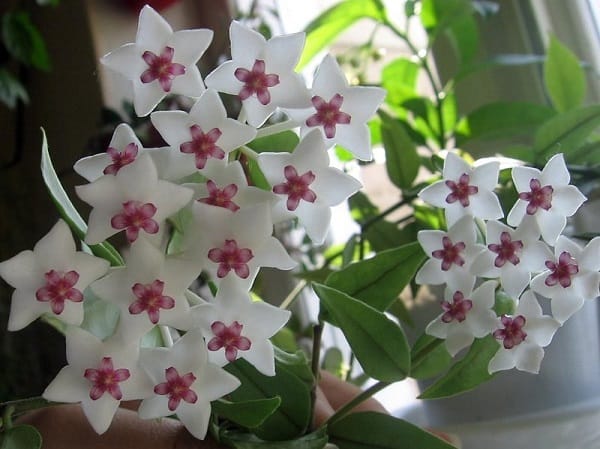

When you can admire her flowers
During the summer months. Seeing flower stalks, do not rejoice too much - they grow for a long 1.5 months, and only when the whole family runs out of patience, amazing wax flowers with pink centers open on the bush.
This process can begin from March to June. It lasts only 8 days. After that, both flowers and peduncles fall off. The plant immediately begins to grow new ones. Thus, you can admire the flowering not only in late May and early summer, but also until the very beginning of autumn.
Hoya flowers smell, their smell resembles vanilla. Personally, I like this scent, but my husband complains that he is too strong and even suffocating. So it is not surprising that we have this plant blooming in the kitchen - that's where the delicious smell of vanilla really belongs!
An important point! When bella is blooming (even after seeing a peduncle), the pot cannot be moved to another window sill. I also do not recommend turning the other side to the sun.
If you collect flowers of all kinds and varieties of hoi, you get a beautiful picture in which white shades will prevail, but yellow, pink, and even burgundy will turn on. And what forms do such flowers sometimes take!
All the splendor of the Hoi bloom is in this video:
Is hoya poisonous, what superstitions surround her
As for the toxicity - yes, it's true. Therefore, I would not advise young parents to grow this plant (until the child is at least four years old), as well as owners of vegetarian cats who love to chew on flowerpots.
With regard to superstitions, hoya, like ordinary indoor ivy, is considered a "muzhigong" and an energy vampire.
True, I once watched a program with a speaking psychic, and he, on the contrary, said that all ivy is a natural “calmness” that helps to establish family conflicts, and if a married woman blooms, then it’s joy at all, which means her husband is true.
You will hear more about the superstitions associated with home flowers (with a reasonable criticism of popular prejudices) in this video:
The most popular varieties of Hoya Bella
Hoya is a genus in which botanists have about 200 species. However, only a few entered our apartments. The most popular ones are:
- Variegata. The leaves of such a plant are decorated with yellowish, light green stains.
>
- Louis Buis (also a variegated variety). A beautiful variety with light centers of leaves, each of which is decorated with a green "frame".
- Wee. The leaves of this plant are smaller than those of other hoya varieties. They are often placed on the stem, so Bella vines look very "fluffy", and the bushes look thick.
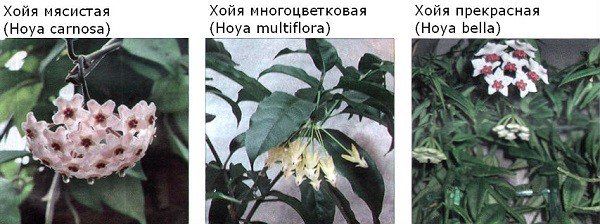

Beneficial features
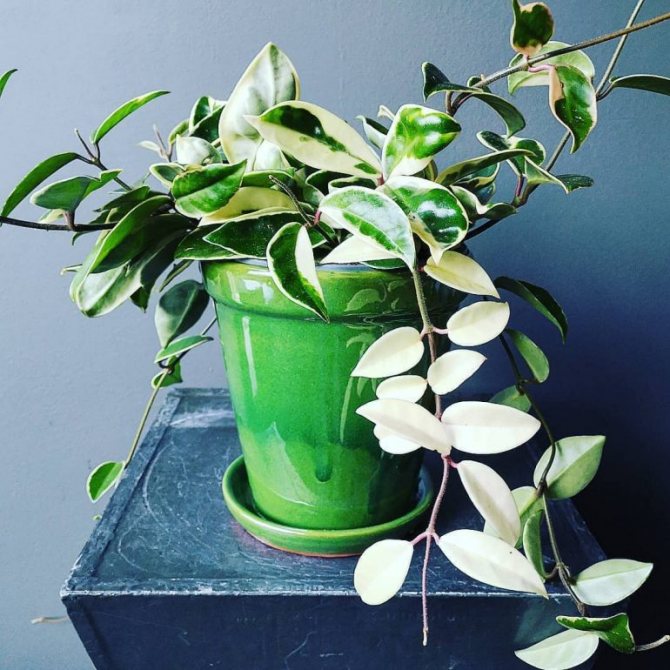

Photo of a hoya in a pot
Medicinal plant:
- helps to eliminate nervous disorders, head migraines, chronic skin diseases (furunculosis, carbunculosis).
- the aroma of the plant's inflorescences is considered an aphrodisiac.
According to superstitions, Noua is an energy vampire, the plant is credited to the group of green "muzhegon". Flower lovers, devoid of prejudice, consider hoya a guarantee of family well-being, a guardian of the house against envy.
Is the flower to blame for human troubles
People tend to blame anyone for their troubles, but not themselves. This happens because a person is used to constantly shifting his responsibility onto others' shoulders. Hoya is a great example of how a harmless flower can become a real monster in the eyes of people.
Distrust is already caused by the fact that all the signs and superstitions about the hoya kerry flower are filled with contradictions. Believe in them or not is everyone's business. But one thing is known for sure: only the person himself is to blame for his troubles and failures.

